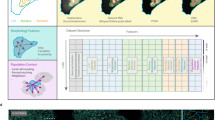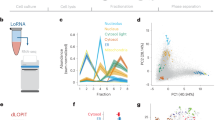Abstract
The nucleolus is a key organelle that coordinates the synthesis and assembly of ribosomal subunits and forms in the nucleus around the repeated ribosomal gene clusters. Because the production of ribosomes is a major metabolic activity, the function of the nucleolus is tightly linked to cell growth and proliferation, and recent data suggest that the nucleolus also plays an important role in cell-cycle regulation, senescence and stress responses1,2,3,4. Here, using mass-spectrometry-based organellar proteomics and stable isotope labelling5, we perform a quantitative analysis of the proteome of human nucleoli. In vivo fluorescent imaging techniques are directly compared to endogenous protein changes measured by proteomics. We characterize the flux of 489 endogenous nucleolar proteins in response to three different metabolic inhibitors that each affect nucleolar morphology. Proteins that are stably associated, such as RNA polymerase I subunits and small nuclear ribonucleoprotein particle complexes, exit from or accumulate in the nucleolus with similar kinetics, whereas protein components of the large and small ribosomal subunits leave the nucleolus with markedly different kinetics. The data establish a quantitative proteomic approach for the temporal characterization of protein flux through cellular organelles and demonstrate that the nucleolar proteome changes significantly over time in response to changes in cellular growth conditions.
This is a preview of subscription content, access via your institution
Access options
Subscribe to this journal
Receive 51 print issues and online access
$199.00 per year
only $3.90 per issue
Buy this article
- Purchase on Springer Link
- Instant access to full article PDF
Prices may be subject to local taxes which are calculated during checkout




Similar content being viewed by others
References
Visintin, R. & Amon, A. The nucleolus: the magician's hat for cell cycle tricks. Curr. Opin. Cell Biol. 12, 752 (2000)
Guarente, L. Link between aging and the nucleolus. Genes Dev. 11, 2449–2455 (1997)
Sherr, C. J. & Weber, J. D. The ARF/p53 pathway. Curr. Opin. Genet. Dev. 10, 94–99 (2000)
Olson, M. O. Sensing cellular stress: another new function for the nucleolus? Sci. STKE [online] pe10 (2004) (doi:10.1126/stke.2242004pe10)
Aebersold, R. & Mann, M. Mass spectrometry-based proteomics. Nature 422, 198–207 (2003)
Mauramatsu, M., Smetana, K. & Busch, H. Quantitative aspects of isolation of nucleoli of the Walker carcinosarcoma and liver of the rat. Cancer Res. 25, 693–697 (1963)
Huh, W. K. et al. Global analysis of protein localization in budding yeast. Nature 425, 686–691 (2003)
Andersen, J. S. et al. Directed proteomic analysis of the human nucleolus. Curr. Biol. 12, 1–11 (2002)
Trinkle-Mulcahy, L., Sleeman, J. E. & Lamond, A. I. Dynamic targeting of protein phosphatase 1 within the nuclei of living mammalian cells. J. Cell Sci. 114, 4219–4228 (2001)
Li, D., Meier, U. T., Dobrowolska, G. & Krebs, E. G. Specific interaction between casein kinase 2 and the nucleolar protein Nopp140. J. Biol. Chem. 272, 3773–3779 (1997)
Yamamoto, R. T., Nogi, Y., Dodd, J. A. & Nomura, M. RRN3 gene of Saccharomyces cerevisiae encodes an essential RNA polymerase I transcription factor which interacts with the polymerase independently of DNA template. EMBO J. 15, 3964–3973 (1996)
Charroux, B. et al. Gemin4. A novel component of the SMN complex that is found in both gems and nucleoli. J. Cell Biol. 148, 1177–1186 (2000)
Lamond, A. I. & Earnshaw, W. C. Structure and function in the nucleus. Science 280, 547–553 (1998)
Misteli, T. Protein dynamics: implications for nuclear architecture and gene expression. Science 291, 843–847 (2001)
Lamond, A. I. & Sleeman, J. E. Nuclear substructure and dynamics. Curr. Biol. 13, R825–R828 (2003)
Leung, A. K. & Lamond, A. I. In vivo analysis of NHPX reveals a novel nucleolar localization pathway involving a transient accumulation in splicing speckles. J. Cell Biol. 157, 615–629 (2002)
Ong, S. E. et al. Stable isotope labeling by amino acids in cell culture, SILAC, as a simple and accurate approach to expression proteomics. Mol. Cell. Proteomics 1, 376–386 (2002)
Blagoev, B., Ong, S. E., Kratchmarova, I. & Mann, M. Temporal analysis of phosphotyrosine-dependent signaling networks by quantitative proteomics. Nature Biotechnol. 22, 1139–1145 (2004)
Perry, R. P. & Kelley, D. E. Inhibition of RNA synthesis by actinomycin D: characteristic dose-response of different RNA species. J. Cell. Physiol. 76, 127–139 (1970)
Raghavan, A. et al. Genome-wide analysis of mRNA decay in resting and activated primary human T lymphocytes. Nucleic Acids Res. 30, 5529–5538 (2002)
Tschochner, H. & Hurt, E. Pre-ribosomes on the road from the nucleolus to the cytoplasm. Trends Cell Biol. 13, 255–263 (2003)
Dragon, F. et al. A large nucleolar U3 ribonucleoprotein required for 18S ribosomal RNA biogenesis. Nature 417, 967–970 (2002)
Eisen, M. B., Spellman, P. T., Brown, P. O. & Botstein, D. Cluster analysis and display of genome-wide expression patterns. Proc. Natl Acad. Sci. USA 95, 14863–14868 (1998)
Tamm, I., Hand, R. & Caliguiri, L. A. Action of dichlorobenzimidazole riboside on RNA synthesis in L-929 and HeLa cells. J. Cell Biol. 69, 229–240 (1976)
Mattsson, K., Pokrovskaja, K., Kiss, C., Klein, G. & Szekely, L. Proteins associated with the promyelocytic leukemia gene product (PML)-containing nuclear body move to the nucleolus upon inhibition of proteasome-dependent protein degradation. Proc. Natl Acad. Sci. USA 98, 1012–1017 (2001)
Olsen, J. V., Ong, S. E. & Mann, M. Trypsin cleaves exclusively C-terminal to Arginine and lysine residues. Mol. Cell. Proteomics 6, 608–614 (2004)
Leung, A. K. et al. Quantitative kinetic analysis of nucleolar breakdown and reassembly during mitosis in live human cells. J. Cell Biol. 166, 787–800 (2004)
Masson, C. et al. Conditions favoring RNA polymerase I transcription in permeabilized cells. Exp. Cell Res. 226, 114–125 (1996)
Boisvert, F. M., Hendzel, M. J. & Bazett-Jones, D. P. Promyelocytic leukemia (PML) nuclear bodies are protein structures that do not accumulate RNA. J. Cell Biol. 148, 283–292 (2000)
Scherl, A. et al. Functional proteomic analysis of human nucleolus. Mol. Biol. Cell 13, 4100–4109 (2002)
Acknowledgements
We thank A. Fox for providing the HeLaYFP–p68 cell line and other members of the Lamond and the Mann laboratories for help and discussions. Work in the Center for Experimental Bioinformatics (CEBI) is supported by a grant from the Danish National Research Foundation. A.I.L. is a Wellcome Trust Principal Research Fellow and is funded by a Wellcome Trust Programme grant; A.K.L.L. was funded by a Croucher studentship; Y.W.L. was funded by The Human Frontier Science Program, which is also acknowledged for a network grant entitled ‘Functional organization of the cell nucleus investigated through proteomics and molecular dynamics’.
Author information
Authors and Affiliations
Corresponding authors
Ethics declarations
Competing interests
The authors declare that they have no competing financial interests.
Supplementary information
Supplementary Legends
This document contains the legends for Supplementary Figures S1 and S2, and legends for Supplementary Tables 1 and 2. (DOC 30 kb)
Supplementary Figure S1
Electron micrograph details of isolated HeLa nucleoli that are structurally intact and transcriptionally active. (PDF 2216 kb)
Supplementary Figure S2
Hierarchical clustering of 302 nucleolar proteins arranged by similarity in their response to Actinomycin-D treatment. (PDF 331 kb)
Supplementary Table 1
The nucleolar proteome. (XLS 3108 kb)
Supplementary Table 2
Nucleolar proteome dynamics after actinomycin D treatment. (XLS 3590 kb)
Rights and permissions
About this article
Cite this article
Andersen, J., Lam, Y., Leung, A. et al. Nucleolar proteome dynamics. Nature 433, 77–83 (2005). https://doi.org/10.1038/nature03207
Received:
Accepted:
Issue Date:
DOI: https://doi.org/10.1038/nature03207
This article is cited by
-
Physiology and pharmacological targeting of phase separation
Journal of Biomedical Science (2024)
-
RGS6 drives cardiomyocyte death following nucleolar stress by suppressing Nucleolin/miRNA-21
Journal of Translational Medicine (2024)
-
Reduced ADP off-rate by the yeast CCT2 double mutation T394P/R510H which causes Leber congenital amaurosis in humans
Communications Biology (2023)
-
Nucleolar URB1 ensures 3′ ETS rRNA removal to prevent exosome surveillance
Nature (2023)
-
Current research on viral proteins that interact with fibrillarin
Molecular Biology Reports (2023)
Comments
By submitting a comment you agree to abide by our Terms and Community Guidelines. If you find something abusive or that does not comply with our terms or guidelines please flag it as inappropriate.



